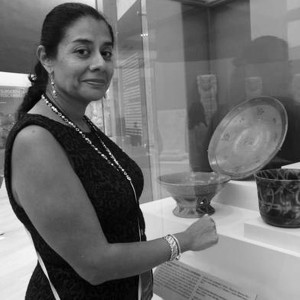A Mayan City of the Late Postclassic
For many years the excavation and research of the Late Postclassic sites on the east coast of present-day Quintana Roo was dismissed because the buildings lacked the magnificence of the previous periods, and because it was thought that the Maya of later periods had fallen into decadence after the so-called "collapse" of the ninth and tenth centuries. Nevertheless, recent research and new approaches to interpretation have demonstrated that Postclassic society, of which San Miguelito was a part, was highly complex and had an efficient production system.
The excavations carried out on site by Sandra Elizalde in 2011 and 2012 revealed in detail the characteristics of a site of enormous interest for the understanding of the Postclassic history of the east coast, since a significant number of residential structures were excavated, as well as the dwellings of the elite, administrative buildings and a pyramid, which together make up the principal elements of Mayan settlements in the northeast of the Yucatan peninsula during the period between 1300 and 1550.
It is interesting to note that San Miguelito would appear to be built in two sectors, one exclusively residential located in the northern part of the settlement, and the other in the south with masonry dwellings, administrative facilities and a plinth which appears to be more closely related to the structures of the El Rey archeological site than to the rest of San Miguelito. These elements seem to show that the internal configuration of the site changed at various times within the Late Postclassic. If this hypothesis is correct, the oldest buildings in the first phase of the San Miguelito site were contemporary with the buildings of the neighboring site of El Rey. The following structures would have been built shortly afterwards: the palace, the buildings for the elite and finally the residential platforms of the north sector which supported houses made from perishable materials.
This conclusion does not imply that the older areas of this archeological site would have been abandoned. On the contrary, we think that the whole of the site was inhabited until the end of its pre-Hispanic occupation and that its inhabitants made various changes to the structures, reusing and dismantling parts of them to adapt them to the changing circumstances and the growth of the town. The large quantity of molluscs, turtle bones and weights for fishing nets found on the residential platforms of the north sector of San Miguelito show that their inhabitants were strongly dependent on the produce of the sea for their living (Elizalde, 2015). Nevertheless an analysis of skeletal remains by Allan Ortega (2016) seems to point to a deterioration in people’s state of health, especially the youngest, as well as significant deterioration among adults from exposure to tough working conditions. Since the majority of the burials of this description were found in the northern sector of the city, it is probable that these homes were built when the Spanish were already present in the peninsula, which would explain the deterioration in the quality of living standards of its inhabitants and the presence of a prismatic blade manufactured with pre-Hispanic technology, but using European glass as the primary material (Elizalde, op cit).
In the light of this evidence, a visit to San Miguelito is very enriching, and encourages us to find out more about a period in the history of the ancient Maya which far from being one of decline, is of great interest for our understanding of the social and economic structure of Mayan civilization at the time of the conquest, as well as the responses of its inhabitants to the failed attempts at subjugation and colonization by the Europeans.







